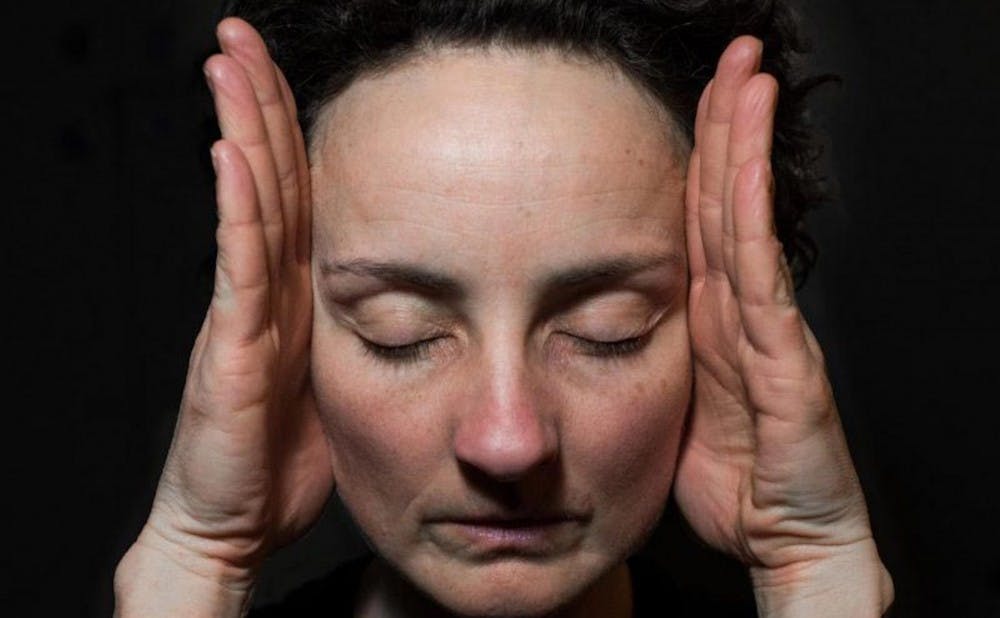It is almost as if Don DeLillo’s “The Body Artist” was always meant to be adapted for the stage, as if some invisible force was, for years, guiding director-writer Jody McAuliffe, Rachel Jett — who plays Lauren Hartke, the body artist — and all their collaborators toward this project. Or at least that’s how it sounded to me when McAuliffe, professor of the practice of theater studies and professor of Slavic and Eurasian studies, told me about the origins of “The Body Artist.”
According to the Duke Performances website, all three shows have already sold out, but those lucky enough to have secured tickets will get to see the product of McAuliffe and company’s work performed at Reynolds Industries Theater Jan. 25, 26 and 27.
“The Body Artist” is the story of Lauren Hartke, who, in the wake of a loss, encounters a ghostly stranger in her remote, rented house out on the coast. The visitor is not ominous, per se, but he is confounding. He speaks in a mishmash of tenses and voices, which, in their whole, seem to mean quite a lot. Together, Lauren and the visitor grapple, in one way or another, with questions of “grief, time and love.”
When McAuliffe first read “The Body Artist,” back when the novel was still in proof, she contacted DeLillo right away.
“I read ['The Body Artist'] when it first came out and wrote to Don immediately because I loved it,” McAuliffe said. “It reminded me of dreams I had had, and I just really connected to the novel on a very deep level, and told him that.”
At the time, McAuliffe was still at work on her adaptation of “Mao II,” another of DeLillo’s novels. And while that production went up in April 2002, it would be more than a decade before the stage version of “The Body Artist” began to coalesce.
Jett, who serves as artistic director of the National Theatre Institute, drove to Duke to see McAuliffe's adaptation of “Mao II,” and wound up speaking with DeLillo — in attendance for the performance — about “The Body Artist” and Marina Abramović. McAuliffe was teaching at The O’Neill in 2015. It was there that Jett and McAuliffe discovered the connection from years before.
“So I’m at The O’Neill in 2015 and I mention [‘Mao II’], and she says, ‘Oh my god, I can’t believe it; I was there,’” McAuliffe recalled.
After McAuliffe reached out to DeLillo and received his permission for the adaptation, she and Jett — who is an expert in the movement system created by Andrei Droznin — began a series of Skype conversations in which they read “The Body Artist,” and two of DeLillo’s other novels, “Point Omega” and “Falling Man,” out loud to each other. From there, they did a workshop at Duke, did additional work at the National Theatre Institute and the Collapsable Hole performance space in New York and then did a production at Abrons Art Center. All of this led up to the arrival of “The Body Artist” at Reynolds Industries Theater later this month.
The production is full of Duke connections. Jim Findlay, who worked on the video and set design, is one of McAuliffe’s former students; he also loves the work of DeLillo. Tavish Miller, the actor who plays the visitor, the apparition-like man in Lauren’s house, previously worked with McAuliffe on a production of Sibyl Kempson’s “Let Us Now Praise Susan Sontag,” also at Abrons. Kempson later came to Duke for a workshop with students. McAuliffe’s husband, Frank Lentricchia — novelist, literary critic and retired literature professor — plays Lauren’s husband Rey in the first scene, in video form. DeLillo and McAuliffe became friends through Lentricchia, who is the preeminent critic of DeLillo’s novels.
“There’s a lot of great history in the room of my former students and people I’ve met through interesting connections,” McAuliffe said. “I ended up at The O’Neill because of Preston Whiteway, who’s a Duke alum and who runs The O’Neill, and he said, ‘Oh, we’ve got to get you up here to teach, we need to get you in touch with Rachel Jett,' and so without Preston none of this would have happened.”
DeLillo came to rehearsal and saw the production. McAuliffe said he was pleased.
“I can't give you a direct quote, but basically he said he was very pleased, that he felt like he had seen the novel come to life on the stage,” she said.
Get The Chronicle straight to your inbox
Sign up for our weekly newsletter. Cancel at any time.

